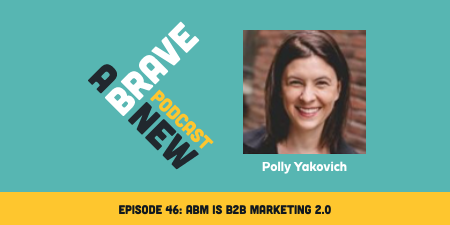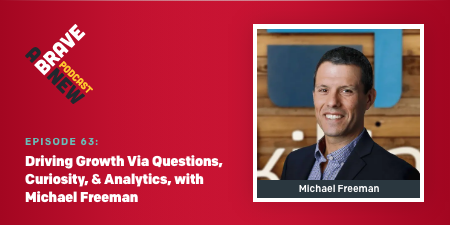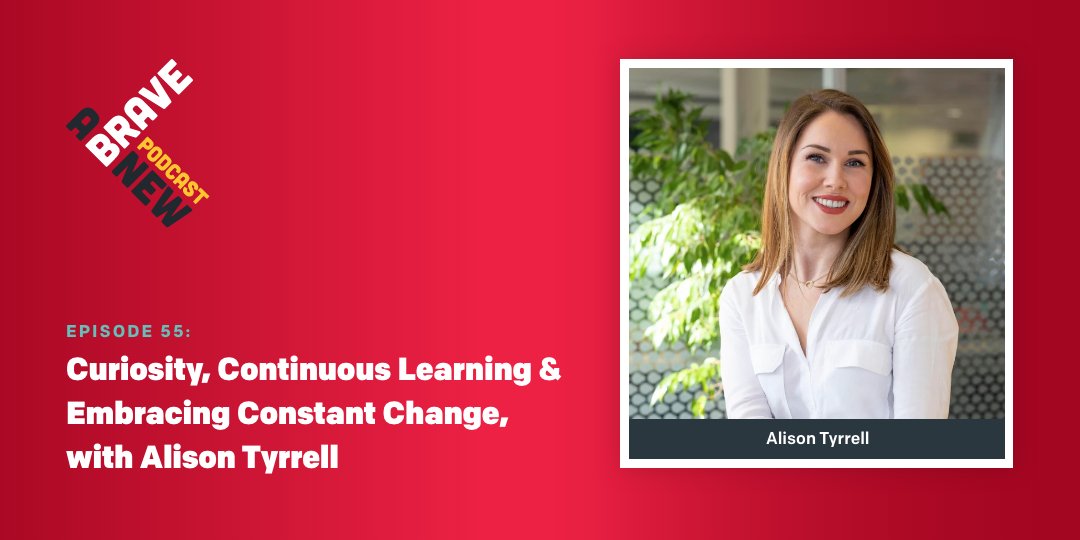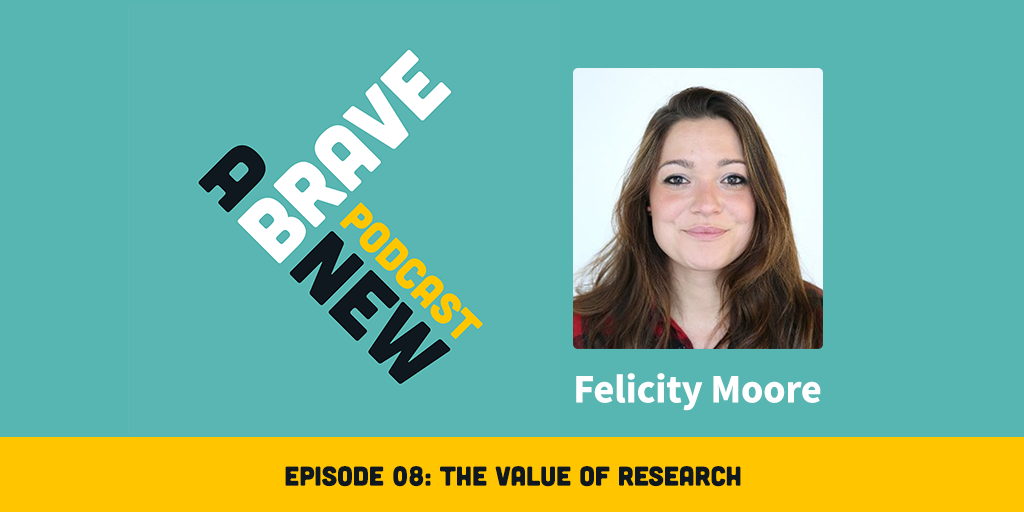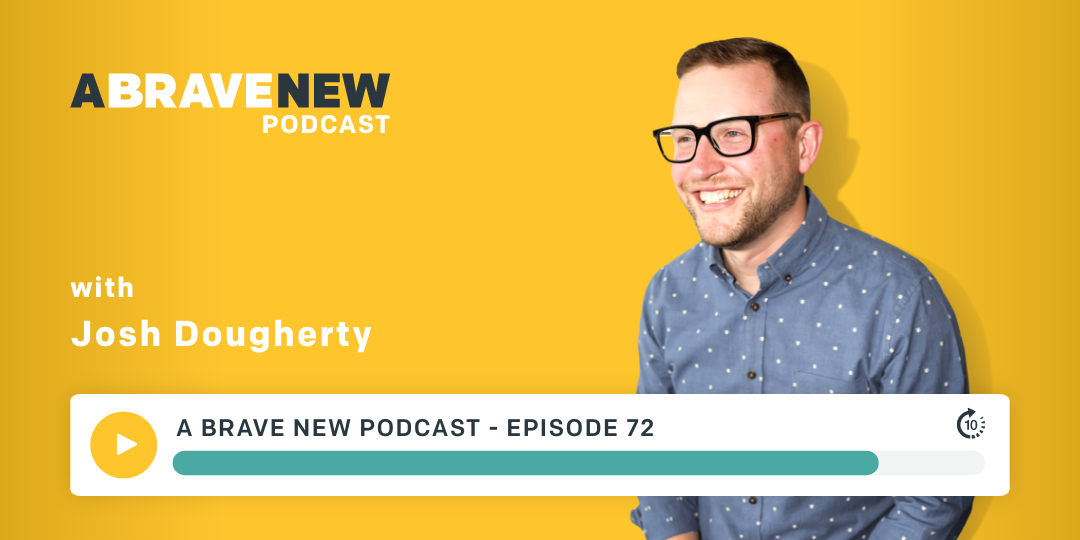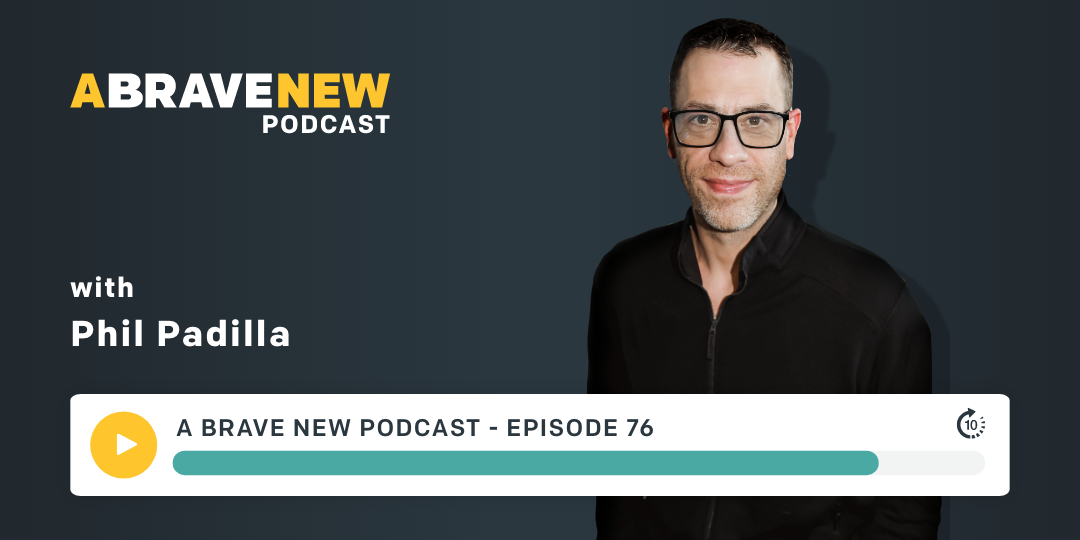Josh Dougherty is a brand strategist, speaker, and the founder and CEO of A Brave New, a Seattle-based B2B digital marketing agency specializing in tech and healthcare. Over the last decade plus, he’s worked with clients to develop unique brands and accelerate business growth using web design, inbound marketing, account-based marketing strategies.
What you’ll learn about in this episode:
- How to market a complex product in four steps:
- Clarifying what you're really selling
- Building trust with humans
- Importance of being data driven
- Keeping the balance between not getting lost in features and functionality, and not oversimplifying
Additional resources:
- How to Market A Complex Tech Product Blog Post
- Erich Ziegler Podcast
- Fabian Geyrhalter Podcast
- Josh Dougherty on LinkedIn
- A Brave New’s Website
Transcript:
Intro:
Welcome to A Brave New Podcast. This is a show about branding and marketing, but more than that, it's an exploration of what it takes to create brands that will be remembered, and how marketing can be a catalyst for those brands' success. I'm Josh Dougherty, your host. Let's dive in.
Josh:
So, today I want to dive into a topic that is really important to most of the CMOs that I talk with. It's the problem they're trying to solve every day, and that's how do they effectively market a complex tech product, especially in the B2B space? And I think there's a couple things that are really important to think through as they do this. But really when I think about this, I think back about one of the first major tech conferences I went to, which was South by Southwest Interactive back in 2011. And if you've ever been to the interactive portion of South by Southwest, you know that it's a pretty crazy time. It's one hell of a party, right?
Some of the things I remember back then, though, was that people were pushing QR codes for the first time. I remember these hilarious shirts that had a full QR code printed in full size on the T-shirt, and they were a total flop at that point. So QR codes in 2011, turns out they're about, I don't know, nine years ahead of their time. Now we're all used to using them because of the pandemic, and I think because it's integrated into our iPhone.
But the other thing I remember that's maybe more relevant to this conversation is there was so much noise produced by the tech companies that were trying to woo attendees to their product, to why it was better than all the other products, trying to catch attention. And it kind of worked, right? But mostly it worked because people like me who were there to learn, there to grow, there to network, really wanted to just go to a bunch of parties and get some free drinks. So we might do that with the companies that were hosting their events.
And you may be wondering, why am I talking about this as we think about marketing a complex tech product? And I think it's because everyone at that interactive conference back then, I think it's the same for any conferences today, are kind of screaming and trying to do the same thing, come to our event, get a free drink, we're going to do the rope process of marketing a product, and the results is this wall of noise where really no one stands out. And I think it's the same for any tech marketer who's trying to punch through and make an impact online getting traction for their brand today, especially in the B2B space.
One of the things that has struck me as I talk to more and more CMOs is the fact that sometimes maybe the loudest person in the room wins the moment, so the person who had the coolest happy hour, the person who threw the best party, but in my experience, it really pays to be a bit contemplative, to sit back and assess the situation, make shifts, move forward decisively, that you can win in the long run if you choose to be a little bit different.
And so that's what I want to unpack today as we talk about marketing a complex product. How do you do that? How do you build a winning campaign? And there's really four things I'm going to walk through. The first is really in this area of clarifying what you're really selling. Then we'll talk about how to build trust with real humans. We'll talk about using lead math to guide your decisions, and not getting lost in features and functionality while also not oversimplifying. And I think all these principles can end up creating a successful marketing effort for something that's even difficult to understand, or maybe you're highly technical.
So let's talk about what you're really selling first. And this might not be a surprise to you because of all the times I talk about differentiation, standing out, et cetera. But, I believe selling a complex tech product, and that's been born out in the clients that I've worked with, is that it's all about brand. We're often rushing to get started to get the next marketing tactic out, to maybe take advantage of the next new tactic that we think is going to be hot. But at the end of the day, your marketing's going to only be effective if there's a ‘there’ there. There's something behind your brand that is really going to make you stand out and going to make you show up in a creative way.
So what I encourage you to do as you're thinking about How can I be more effective with my marketing for my product? is ask yourself and your teams, what are you really selling? One of the companies I like to talk about is one of our technology clients. They do work selling infrastructure to people, helping them design an optimal data center. They help with cloud computing, helping people optimize how they're setting up the cloud, any of the three public clouds, how they're getting their computer and their storage optimized. And they can talk a lot about the ins and outs of details in each of those areas. But at the end of the day, what they're selling is this idea of clarity.
There's this disruptive technology landscape, right? There's constantly changing tech, there's constantly changing business requirements, business environments. And what they're saying is, we can help you get clarity about how to optimize your tech spend. And so that's an example of someone understanding What are we really selling so that we can show up differently in the market?
An example from the B2C arena and a company that I really look up to is this idea of Airbnb. They're not doing much different than many other travel companies. They're providing you a place to stay, a place to sleep when you're on the road or traveling somewhere. But what they're really selling you is this chance to travel like a local, to feel like you're belonging somewhere.
And you may say, "Hey, Airbnb is a much simpler product than I'm selling, and they're selling to consumers," but the principle is still the same. What is that thing that you can really tap into that is connected to the human emotions that you're solving for people? Because when I talk about that tech client I just talked about, just as much as Airbnb, they're helping different organizations, and more importantly, chief technology officers, chief information officers, get clarity about what to do. They're helping them appear smarter with the rest of the leadership. They're helping them solve thorny problems. They can go to sleep, trusting that they've got things tackled. They're helping them get a view into the future and how to future-proof their business, and all those things are more than just specific benefits to them as a business person, but it benefits them from an emotional, psychological perspective as well.
So, first thing as you're thinking about selling this complex technology product is to think about how do we get beyond the features and the obvious benefits to what are we really selling to someone? How do we make that connection on an emotional level? And I'll include in the show notes a recent conversation I had with Fabian Geyrhalter, who is another brand strategist that I really appreciate ... I've mentored with him with the Founders Institute for a couple years. And in that conversation, we talk a lot about how to build a brand, and he shares about his concept of how to build a brand with soul. And I think that conversation will be really relevant if you're trying to get to the bottom of how do we show up differently so we can build these emotional connections across with organizations and the people in the organizations we're trying to build relationships with.
Which brings me to my next topic, which is you effectively market a complex tech product by building trust with humans. So one of the mistakes we often make as B2B marketers is forgetting who we're selling to. You just heard me a little bit in this previous few minutes, even say this, where I said, "We're marketing to organizations." We aren't. We shouldn't get over-awed by the big corporations we're seeking to impress, because when we start thinking about that, and I look at maybe, I don't know, if I'm trying to sell into a massive company like Zoom, it's easy to get intimidated. I can easily make the dangerous assumption that I need to be a little more professional, that I need to be just a little more technical to be effective to break through. I forget that I'm marketing to a human, even if I'm selling to a highly expert audience, like software developers. At the end of the day, the person who's going to make that purchase decision is a human.
And so, sure, they're going to want to see the justification for why your product is the best on the market, why it's the best for them, why it provides incredible value. All those things are important. They're going to also probably want to see some proof that you can deliver and that you're going to fulfill on the promises that you're making on your product. But to get even into that conversation, you're going to have to make sure these people feel heard, they feel understood, they feel supported, because that's kind of the entry point. We're bombarded as marketers. As people who are really successful in our roles, we're bombarded by all sorts of messages. And until we feel someone understands us, we're not going to pay attention. Humans make buying decisions based on their feelings and their emotions. Doesn't matter how complex the decision is.
So if we take a step back here and we think about any product, say we're selling an enterprise reporting software that's going to revolutionize how you can look at your business metrics. If someone's evaluating reporting software, there's probably a number of solutions that are similar to yours. Yours may do one thing the best, it probably should if it's going to stand out, but they have multiple viable options, and they're figuring out pros and cons, et cetera. And they're going to go with a brand they connect with the most generally. If everyone has a similar feature set, they're going to say, "Who understands my business the most? Who cares most about me? Who wants to help me the most? Who is solving my challenges the most?"So in our marketing, we've got to be focused on building that human connection so that when we get to a place where they've seen what we do, they trust what our product can, our service can deliver, and they're just evaluating which of these people do I want to work with the most? We need to make sure we built that trust.
So far, we've talked about understanding what you're really selling, remembering that we're marketing with humans, and we need to build trust so that they're going to choose to move forward with us. And then the next piece of information I think we've got to think about is being data driven, which is a little bit different than everything else we've talked about so far, right? Because we've been talking about maybe the intangibles, the ways to get noticed, but then there's a reality that we also need to be data driven and make sure we're optimizing the money that we have. And so one of the best ways to talk about this is understanding your lead math.
If I understand how much it costs for me to get a dollar a pipe or a $1000 or $100,000 a pipeline or a million dollars into my pipeline, and I can reverse engineer that back to how much it costs me to get a lead in any channel, I'm going to be more effective as a marketer because I'm going to be able to then look at my channel mix, whether it's 5, 10, 15 channels that you're going after, depending on the complexity of your marketing program, and say, "Okay, these three channels," say LinkedIn advertising, the webinars that we're doing, and blogging, for example. I'm not saying these are the most effective channels, but these, for our fictional company we're talking about right now, are driving the most pipeline. They are going to be able to shift money into those areas so that you can continue to drive more and more pipeline there and shift money away.
But to be able to make those types of decisions and to be able to drive results in that way, you've got to understand what is the fully loaded cost per acquisition in each of those channels? And not only that, when you can understand what that cost per acquisition or even the cost per pipeline value in one of those channels, you're able to then understand when are we beginning to max out the potential of that channel? And we should be looking at other options.
So many of us, I think, say, "Well, it's hard to get that fully loaded cost per acquisition, or it's hard to really get that metrics driven where I can do a math equation for each of my channels to understand how much it costs for me to get a lead in the door." But doing that work is going to allow us to optimize our spend, justify marketing to the C-suite, and drive the best results.
If you want to learn more about this, I'll also include a note in this podcast about my conversation with Erich Ziegler, who is a brilliant marketer, formally working at Netflix and RingCentral. He goes in depth about his kind of approach to lead math. I think you'll find it valuable. So check that out after you listen to this podcast if you're interested. And this combination, I just encourage you that this combination of a really data driven lead math approach and then a focus on what you're really selling and making what you're really selling appealing to humans is going to be powerful, right? Because then you're breaking through the noise and you're optimizing at the same time, which leads me to the next point that I wanted to talk about or make, which is let's not get lost in features and functionality. And also, let's not oversimplify.
So to talk about this, I want to talk about a health tech firm in the pharmaceutical space that I worked with many years ago. One of the things that was difficult about their marketing was their desire to dive deep into every single facet of their product. They wanted to write PhD level content regardless of the medium and the firm. They really struggled with an over-emphasis on features and functionality. They were so focused on kind of highlighting all the finer points of their platform that the benefits got lost, and really the results were predictable. The content made it very clear that they had a complex and advanced product. You would read through and understand, yeah, this is complex, but it was difficult to tell how it would benefit the people who bought it.
And so I think when we started working with them, there was a huge need to actually simplify. But if you're in this situation, I think your knee-jerk reaction is to oversimplify, and I want to encourage you not to do that. You don't want to be so lost in the features and functionality that people can't see benefits, but you also don't want to oversimplify. We made this mistake as we were starting to work with this client. We tried to humanize the content, make it digestible and readable, and we really over-corrected where all of a sudden our client was like, "You make us sound like we don't even know what we're doing in this space, because you're trying to be so human."
And so this is where collaboration with different teams, having those critical conversations with each other to see, to evaluate what you're doing, to evaluate your messaging and make sure that you're speaking correctly or having the most impact are important because the client was willing to be a collaborator and really get in. And while we had over-corrected into simplicity, they provided that opposing voice. They said, "How do we capture that human simple marketing voice, but also make sure the content is technical enough and speaks enough about the features and functionality to make them trustworthy in this space? How do we speak enough about, inappropriately enough about the pharmaceutical industry and how they work in order to build trust there?" And this middle ground between complexity, features and functionalities and human and simple is really the important balance we have to strike, because that allows us to build those connections, but also build the credibility of the organizations that we're working with. And that's what you need to do as well. You’ve got to build the credibility of and also build the human connection with the people you're selling to.
So just to review what we've talked about. We've talked about clarifying what you're really selling, what's the thing behind your product? Or building trust, we talked about needing to build trust with humans because at the end of the day, if there's comparable product, people are going to go with the people that they trust the most. We talked about using those two core principles and then implementing lead math to be able to really map out what is the cost of acquisition for each channel. And then we talked about not getting lost in features and functionality, but also not oversimplifying so you lose credibility in space.
And all this is really philosophical. So I want to zoom down to ... Maybe not zoom down and talk in depth about it, but give you a little context around, at the same time as you're thinking about these high-level things, you need to remember the basics about marketing in tech and not put all your eggs in one basket.
And what does this mean? It means that even though they aren't exciting, you still need to probably create some blog posts, do in depth eBooks and guides. You need to make sure you have a strong paid media and SEO approach that's doing the fundamentals. You need to emphasize the fundamentals when it comes to email automation and lead nurturing. You need to focus on optimization. You need to make sure you're getting positioned well within the Gartner Magic Quadrant for your product sector, product type. These are the basics that we've got to do inside of technology marketing and not just get carried away by looking for the next great tactic.
Now, you also need to be testing new tactics, and this is where your lead math will come in handy. It will help you determine whether new, up-and-coming tactics are going to deliver at the same rate as the other tactics that you're using.
And that's really it. I think we make marketing complex tech problems overly complex, and certainly the tactics can be very complex. But from a high level, I want you to remember you're selling something that appeals to humans. You need to build trust with the people you're selling to. You need to be data driven, you need to be approachable yet credible, and you need to make sure you're doing all the basics while you're implementing new, exciting ideas and use your lead math to guide you there.
So I hope that the content from this podcast, and we'll link to an accompanying blog post that I recently wrote on the same topic, will help you drive things forward at your organization. And I just encourage you to dive in. Now, if you can do this, if you can build your brand, build a unique selling proposition and effectively market your tech product, you're going to be successful, but it's going to require some discipline. It's going to require hard work to prove what works for you, because after all, it's up to you as a marketer to follow the data and chart the right path forward for your brand. This isn't a one-size-fits-all work. I think that's what makes it creative and fun. But it's also, there's some high-level principles, hopefully, that you can take away from this podcast to enhance what you're doing.
And with that, yeah, I'm going to wrap up. I hope you enjoyed this episode. I hope you'll join me next time for a great conversation with another CMO, and I'll see you all soon.
Outro:
Thanks for listening to this episode of A Brave New podcast. Go to abravenew.com for more resources and advice on all things brand and marketing. If you enjoyed this episode, show us some love by subscribing, rating, and reviewing A Brave New Podcast wherever you listen to your podcasts. A Brave New Podcast is created by A Brave New, a brand and marketing agency in Seattle, Washington. Our producer is Rob Gregerson of Legato Productions.
Similar Articles
OCT 11, 2021

The Beginner’s Guide to Generating Inbound Leads
Marketing doesn’t have to be painfully intrusive, like getting yet another telemarketing call right when you sit down to dinner with your family.
OCT 11, 2021

The Beginner’s Guide to Generating Inbound Leads
Marketing doesn’t have to be painfully intrusive, like getting yet another telemarketing call right when you sit down to dinner with your family.


